TIAIELVEIVIONTH
Page 49
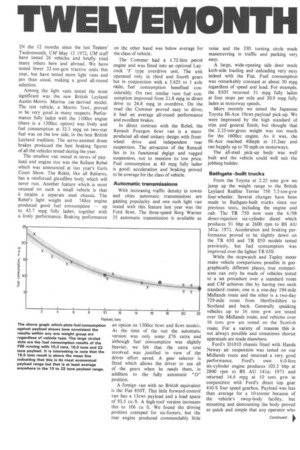
Page 51
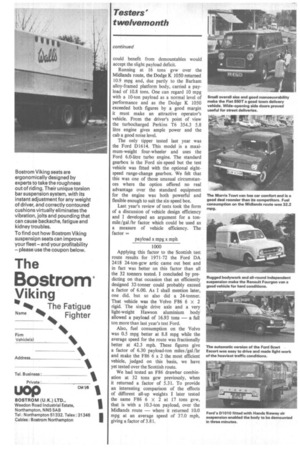
Page 52
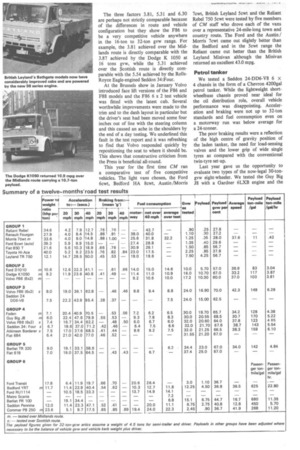
Page 53
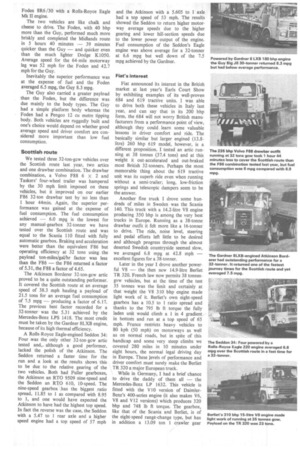
Page 54
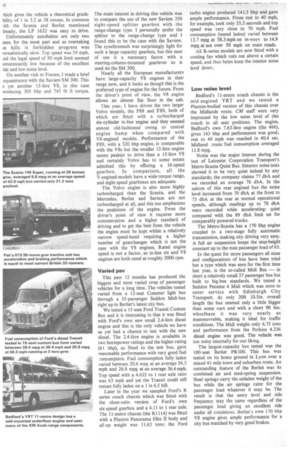
If you've noticed an error in this article please click here to report it so we can fix it.
IN the 12 months since the last Testers' Twelvemonth, CM May 12 1972, CM staff have tested 26 vehicles and briefly tried many others here and abroad. We have tested fewer 32-ton-gcw tractive units this year, but have tested more light vans and psv than usual, making a good all-round selection.
Among the light vans tested the most significant was the new British Leyland Austin-Morris Marina car-derived model. The test vehicle, a Morris 7cwt, proved to be very good in many respects. Performance fully laden with the 1100cc engine (there is a I300cc option) was lively and fuel consumption at 32.3 mpg on two-star fuel was on the low side, in the best British Leyland tradition. The servo-assisted drum brakes produced the best braking figures of all the vehicles tested during the year.
The smallest van tested in terms of payload and engine size was the Reliant Rebel which was announced at last year's Earls Court Show. The Rebel, like all Reliants, has a reinforced glassfibre body which will never rust. Another feature which is most unusual on such a small vehicle is that it retains a separate steel chassis. The Rebel's light weight and 748cc engine produced good fuel consumption — up to 43.7 mpg fully laden, together with a lively performance. Braking performance on the other hand was below average for the class of vehicle,
The Commer had a 1.72-litre petrol engine and was fitted into an optional Laycock 1' type overdrive unit. The unit operated only in third and fourth gears but in conjunction with a 5.625 to 1 axle ratio, fuel consumption benefited considerably. On two similar runs fuel consumption improved from 21.8 mpg in direct drive to 24.8 mpg in overdrive. On the road the Commer proved easy to drive; it had an average all-round performance and excellent brakes.
In direct contrast with the Rebel, the Renault Fourgon 6cwt van is a massproduced all-steel unitary design with frontwheel drive and independent rear suspension. The attraction of the Renault lies in its functional deign and rugged suspension, not to mention its low price. Fuel consumption at 40 mpg fully laden is good; acceleration and braking proved to be average for the class of vehicle.
Automatic transmissions With increasing traffic density in towns and cities automatic transmissions are gaining popularity and one such light van tested with this feature last year was the Ford 8cwt. The three-speed Borg Warner 35 automatic transmission is available as noise and the 33ft turning circle madt manoeuvring in traffic and parking very easy.
A large, wide-opening side door made kerb-side loading and unloading very easy indeed with the Fiat. Fuel consumption was remarkably constant at about 30 mpg regardless of speed and load. For example, the 850T returned 31 mpg fully laden at four stops per mile and 30.9 mpg fully laden at motorway speeds.
More recently we tested the Japanese Toyota Hi-Ace 19cwt-payload pick-up. We were impressed by the high standard of trim and general finish, but thought that the 2.25-ton-gross weight was too much for the 1600ec engine. As it was, the Hi-Ace reached 40mph in 15.2sec and ran happily up to 70 mph on motorways.
The all-steel pick-up body was well built and the vehicle could well suit the jobbing builder.
Bathgate -built trucks From the Toyota at 2.25 tons gvw we jump up the weight range to the British Leyland Redline Terrier 750 7.5-ton-gvw four-wheeler. Several changes have been made to Bathgate-built trucks since our previous tests, including the engine and cab. The TR 750 now uses the 6/98 direct-injection six-cylinder diesel which produces 91 bhp at 2600 rpm to BS AU 141a: 1971. Acceleration and braking performance proved to be slightly down on the TR 650 and TR 850 models tested previously, but fuel consumption was improved over the lighter TR 650.
While the stopwatch and Tapley meter make vehicle comparisons possible in geographically different places, true comparisons can only be made of vehicles tested to a set procedure over a standard route and CM achieves this by having two such standard routes; one is a one-day 194-mile Midlands route and the other is a two-day 729-mile route from Hertfordshire to Scotland and back. Generally speaking vehicles up to 16 tons gvw are tested over the Midlands route, and vehicles over 16 tons gvw are tested on the Scottish route. For a variety of reasons this is not always possible and sometimes shorter appraisals are made elsewhere.
Ford's D1010 chassis fitted with Hands Neway air suspension was tested on our Midlands route and returned a very good performance. Ford's own 6.0-litre six-cylinder engine produces 103.5 bhp at 2800 rpm to BS AU 141a: 1971 and returned 14.6 mpg at 10 tons gvw in conjunction with Ford's direct top gear 410-S four speed gearbox. Payload was less than average for a 10-tonner because of the vehicle's swop-body facility, but mounting and demounting the body proved so quick and simple that any operator who
could benefit from demountables would accept the slight payload deficit.
Running at 16 tons gvw over the Midlands route, the Dodge K 1050 returned 10.9 mpg and, due partly to the Barham alloy-framed platform body, carried a payload of 10.8 tons. One can regard 10 mpg with a 10-ton payload as a normal level of performance and as the Dodge K 1050 exceeded both figures by a good margin it must make an attractive operator's vehicle. From the driver's point of view the turbocharged Perkins T6 354.3 5.8 litre engine gives ample power and the cab a good noise level.
The only tipper tested last year was the Ford D1614. This model is a maximum-weight four-wheeler and uses the Ford 6.0-litre turbo engine. The standard gearbox is the Ford six-speed but the test vehicle was fitted with the optional eightspeed range-change gearbox. We felt that this was one of those unusual circumstances where the option offered no real advantage over the standard equipment for the engine was both powerful and flexible enough to suit the six-speed box.
Last year's review of tests took the form of a discussion of vehicle design efficiency and I developed an argument for a tonmile /gal ihr factor which could be used as a measure of vehicle efficiency. The factor = payload x mpg x mph 1000
Applying this factor to the Scottish test route results for 1971-72 the Ford DA 2418 24-ton-gcw artic came out hest and in fact was better on this factor than all the 32 tanners tested. I concluded by predicting on that occasion that an efficiently designed 32-tonner could probably exceed a factor of 6.00. As I shall mention later, one did, but so also did a 24-tonner. That vehicle was the Volvo F86 6 X 2 rigid. The single drive axle and a very light-weight Hawson aluminium body allowed a payload of 16.93 tons — a full ton more than last year's test Ford.
Also, fuel consumption on the Volvo was 0.5 mpg better at 8.8 mpg while the average speed for the route was fractionally better at 42.3 mph. These figures give a factor of 6.30 payload-ton miles /gal /lir and make the F86 6 x 2 the most efficient vehicle, judged on this basis, we have yet tested over the Scottish route.
We had tested an F86 drawbar combination at 32 tons gew previously, when it returned a factor of 5.31. To provide an interesting comparison of the effects of different all-up weights I later tested the same F86 6 X 2 at 17 tons gvw, that is with a 10.3-ton payload, over the Midlands route — where it returned 10.0 mpg at an average speed of 37.0 mph, giving a factor of 3.81. The three factors 3.81, 5.31 and 6.30 are perhaps not strictly comparable because of the differences in route and vehicle configuration but they show the F86 to be a very competitive vehicle anywhere in the 16-ton to 32-ton gvw range. For example, the 3.81 achieved over the Midlands route is directly comparable with the 3.87 achieved by the Dodge K 1050 at 16 tons gvw, while the 5.31 achieved over the Scottish route is directly comparable with the 5.54 achieved by the RollsRoyce Eagle-engined Seddon 34 :Four.
At the Brussels show in January Volvo introduced face lift versions of the F86 and F88 models and the F86 6 x 2 test vehicle was fitted with the latest cab. Several worthwhile improvements were made to the trim and to the dash layout in particular but the driver's seat had been moved some four inches out of line with the steering column and this caused an ache in the shoulders by the end of a day testing. We underlined this fault in the test report and it was refreshing to find that Volvo responded quickly by repositioning the seat to where it should be. This shows that constructive criticism from the Press is beneficial all-round.
This year for the first time CM ran a comparative test of five competitive vehicles. The light vans chosen, the Ford 6cwt, Bedford HA 8cwt, Austin/Morris 7cwt, British Leyland 5cwt and the Reliant Rebel 750 5cwt were tested by five members of CM staff who drove each of the vans over a representative 24-mile-long town and country route. The Ford and the Austin/ Morris 7cwt came out slightly better than the Bedford and in the 5cwt range the Reliant came out better than the British Leyland Minivan although the Minivan returned an excellent 43.0 mpg.
Petrol tanker
We tested a Seddon 24-DD6-V8 6 X 4 chassis in the form of a Chevron 4200gal petrol tanker. While the lightweight shortwheelbase chassis proved near ideal for the oil distribution role, overall vehicle performance was disappointing. Acceleration and braking were not up to 32-ton standards and fuel consumption even on a motorway run was below average for a 24-tonner.
The poor braking results were a reflection of the high centre of gravity position of the laden tanker, the need for load-sensing valves and the lower grip of wide single tyres as compared with the conventional twin-tyre set-up.
Last year gave us the opportunity to evaluate two types of the now-legal 30-tongvw eight-wheeler. We tested the Guy Big J8 with a Gardner 6003 engine and the Foden 8R6130 with a Rolls-Royce Eagle Mk II engine.
The two vehicles are like chalk and cheese to drive. The Foden, with 40 bhp more than the Guy, performed much more briskly and completed the Midlands route in 5 hours 40 minutes 39 minutes quicker than the Guy and quicker even than the much lighter Dodge K1050. Average speed for the 64-mile motorway leg was 52 mph for the Foden and 42.7 mph for the Guy.
Inevitably the superior performance was at the expense of fuel and the Foden averaged 6.5 mpg, the Guy 8.3 mpg.
The Guy also carried a greater payload than the Foden, but the difference was due mainly to the body types. The Guy had a simple platform body whereas the Foden had a Pengco 12 cu metre tipping body. Both vehicles are ruggedly built and one's choice would depend on whether good average speed and driver comfort are considered more important than low fuel consumption.
Scottish route We tested three 32-ton-gcw vehicles over the Scottish route last year, two artics and one drawbar combination. The drawbar combination, a Volvo F88 6 x 2 and Taskers' four-wheel trailer was hampered by the 30 mph limit imposed on these vehicles, but it improved on our earlier F86 32-ton drawbar test by no less than 1 hour 44min. Again, the superior performance was gained at the expense of fuel consumption. The fuel consumption achieved 6.0 mpg is the lowest for any manual-gearbox 32-tonner we have tested over the Scottish route and was equal to the Scania 110 fitted with fully automatic gearbox. Braking and acceleration were better than the equivalent F86 but operating efficiency at 32 tons using the payload ton-miles/gal/hr factor was less than the F86 the F86 returned a factor of 5.31, the F88 a factor of 4.65.
The Atkinson Borderer 32-ton-gcw artic proved to be a quite outstanding performer. It covered the Scottish route at an average speed of 38.3 mph hauling a payload of 21.5 tons for an average fuel consumption of 7.5 mpg producing a factor of 6.17. The previous best factor recorded for a 32-tonner • was the 5.31 achieved by the Mercedes-Benz LPS 1418. The most credit must be taken by the Gardner 8LXB engine, because of its high thermal efficiency.
A Rolls-Royce Eagle-engined Seddon 34: Four was the only other 32-ton-gcw artic tested and„ although a good performer, lacked the polish of the Atkinson. The Seddon returned a faster time for the run and a look at the results shows this to be due to the relative gearing of the two vehicles. Both had Fuller gearboxes, the Atkinson an RTO 9509 nine-speed and the Seddon an RTO 610, 10-speed. The nine-speed gearbox has the biggest ratio spread, 11.85 to 1 as compared with 8.95 to 1, and one would have expected the Atkinson to have had the highest top speed. In fact the reverse was the case, the Seddon with a 5.47 to 1 rear axle and a higher speed engine had a top speed of 57 mph and the Atkinson with a 5.605 to I axle had a top speed of 53 mph. The results showed the Seddon to return higher motorway average speeds due to the higher gearing and lower hill-section speeds due to the lower power output of the engine. Fuel consumption of the Seddon's Eagle engine was above average for a 32-tonner at 6.6 mpg but well down of the 7.5 mpg achieved by the Gardner.
Fiat's interest
Fiat announced its interest in the British market at last year's Earls Court Show by exhibiting examples of its well-proven 684 and 619 tractive units. I was able to drive both these vehicles in Italy last year, and can say that in its 200 bhp form, the 684 will not worry British manufacturers from a performance point of view, although they could . learn some valuable lessons in driver comfort and ride. The basically similar but larger engined (13.8litre) 260 bhp 619 model, however, is a different proposition. I tested an artic running at 38 tonnes (37.4 tons) and at this weight it out-accelerated and out-braked most British 32-tonners. Perhaps the most memorable thing about the 619 tractive unit was its superb ride even when running without a semi-trailer; long, low-friction springs and telescopic dampers seem to be the answer.
Another fine truck I drove some hundreds of miles in Sweden was the Scania 140. This truck with a 14.2-litre V8 engine producing 350 bhp is among the very best trucks in Europe. Running as a 38-tonne drawbar outfit it felt more like a 16-tormer to drive. The ride, noise level, steering and pedal efforts left little to be desired and although progress through the almost deserted Swedish countryside seemed slow, we averaged 6.8 mpg at 42.8 mph excellent figures for a 38-tonner.
Later in the year I drove another powerful V8 the then new 14.9-litre Berliet TR 320. French law now permits 38 tonnesgvw vehicles, but at the time of the test 35 tonnes was the limit and certainly at that weight the V8 310 bhp engine made light work of it. Berliet's own eight-speed gearbox has a 10.5 to 1 ratio spread and thanks to the 795 lb ft torque the fully laden unit would climb a 1 in 4 gradient in bottom and run at a top speed of 65 mph. France restricts heavy vehicles to 80 kph (50 mph) on motorways as well as on normal roads, but in spite of this handicap and some very steep climbs we covered 280 miles in 10 minutes under eight hours, the normal legal driving day in Europe. These levels of performance and driver comfort must surely make the Berliet TR 320 a major European truck.
While in Germany, I had a brief chance to drive the daddy of them all the Mercedes-Benz LP 1632. This vehicle is fitted with the V10 version of DaimlerBenz's 400-series engine (it also makes V6, V8 and V12 versions) which produces 320 bhp and 748 lb ft torque. The gearbox, like that of the Scania and Berliet, is of the eight-speed range-change type, but has in addition a 13.09 ton 1 crawler gear thich gives the vehicle a theoretical gradebility of 1 in 3.2 at 38 tonnes. In common pith the Scania and Berliet mentioned beady, the LP 1632 was easy to drive.
Unfortunately autobahns are only two Ines for the most part and as overtaking In hills is forbidden progress was mrealistically slow. Top speed was 59 mph, Lnd the legal speed of 50 mph limit seemed innecessarily low because of the excellent ide and low noise level.
On another visit to France, I made a brief .cquaintance with the Saviem SM 300. This s yet another 15-litre V8, in this case )roducing 305 bhp and 745 lb ft torque. The main interest in driving this vehicle was to compare the use of the new Saviem 350 eight-speed splitter gearbox with the range-change type. I personally prefer the splitter to the range-change type and I found this to be the case with the Saviem. The synchromesh was surprisingly light for such a large capacity gearbox, but this ease of use is a necessary factor with a steering-column-mounted gearlever as is used on the SM 300.
Nearly all the European manufacturers have large-capacity V8 engines in their range now, and it looks as though this is the preferred type of engine for the future. From the driver's point of view, the V8 engine allows an almost flat floor in the cab.
This year, I have driven the two larger Volvo models, the F88 and F89, both of which are fitted with a turbocharged six-cylinder in-line engine and they seemed almost Old-fashioned owing to central engine hump when compared with V8-engined models. Performance of the F89, with a 320 bhp engine, is comparable with the V8s but the smaller 12-litre engine seems peakier to drive than a 15-litre V8 and certainly Volvo has to some extent admitted this by offering a 16-speed gearbox. In comparison, all the V-engined-models have a wide torque range, and eight-speed gearboxes are adequate.
The Volvo engine is also more highly turbocharged than the Scania, and the Mercedes, Berliet and Saviem are not turbocharged at all, and this too emphasizes the peakiness of the engine. From the driver's point of view it requires more concentration and a higher standard of driving and to get the best from the vehicle the engine must be kept within a relatively narrow speed-band requiring a higher number of gearchanges which is not the case with the V8 engines. Rated engine speed is not a factor, as in-line six and V8 engines are both rated at roughly 2000 rpm.
Varied psv This past 12 months has produced the biggest and most varied crop of passenger vehicles for a long time. The vehicles tested varied from a 12-seat Commer light bus through a 35-passenger Seddon Midi-bus right up to Berliet's latest city bus.
We tested a 15-seat Ford Transit Custom Bus and it is interesting in that it was fitted with Ford's own new small 2.4-litre diesel engine and this is the only vehicle we have as yet had a chance to test with the new diesel. The 2.4-litre engine is available in two horsepower ratings and the higher rating (61 bhp), as fitted to the test bus, gave reasonable performance with very good fuel :onsumption. Fuel consumption fully laden varied between 20.6 mpg at an average 56.3 mph and 26.8 mpg at an average 36.4 mph. Top speed with a 4.625 to 1 rear axle ratio was 63 mph and yet the Transit could still restart fully laden on a 1 in 6.5 hill.
Later in the year we sampled Ford's R series coach chassis which was fitted with the close-ratio version of Ford's own six-speed gearbox and a 4.11 to 1 rear axle. The 11-metre chassis (the R1114) was fitted with a Plaxton Panorama Elite II body and all-up weight was 11.65 tons; the Ford turbo engine produced 141.5 bhp and gave ample performance. From rest to 40 mph, for example, took only 33.3 seconds and top speed was very close to 70 mph. Fuel consumption (tested laden) varied between 13.7 mpg at 58.3mph on m-ways to 14.9 mpg at not over 50 mph on main roads.
All R-series models are now fitted with a cooling fan which cuts out above a certain speed, and thus helps keep the interior noise level down.
Low noise level Bedford's 11-metre coach chassis is the mid-engined YRT and we tested a Plaxton-bodied version of this chassis over the Midlands route. CM staff were very impressed by the low noise level of this coach in all seat positions. The engine, Bedford's own 7.63-litre engine (the 466), gives 143 bhp and performance was good; rest to 40 mph was reached in 40.4 sec. Midland route fuel consumption averaged 11.8 mpg.
Noise was the major interest during the test of Leicester Corporation Transport's Metro-Scania Quiet Bus. Exterior noise tests showed it to be very quiet indeed by any standards; the company claims 77 dbA and we recorded an average 76 dbA. In the saloon of this rear engined bus the noise level increased from 70 dbA at the front to 73 dbA at the rear at normal operational speeds, although readings up to 78 dbA were recorded while accelerating: quiet compared with the 89 dbA limit set for comparably powered trucks.
The Metro-Scania has a 170 bhp engine coupled to a two-stage fully automatic transmission, making city driving very easy. A full air suspension keeps the step-height constant up to the max passenger load of 65.
In the quest for more passengers all sizes and configurations of bus have been tried but a type which was seen for the first time last year, is the so-called Midi Bus in short a relatively small 37 passenger bus but built to big-bus standards. We tested a Seddon Pennine 4 Midi which was soon to enter service with Edinburgh City Transport. At only 20ft 10.51n. overall length the bus seemed only a little bigger than some cars and with a short 9ft 6in. wheelbase it was very nearly as manoeuvrable, making it ideal for traffic conditions. The Midi weighs only 6.75 tons and performance from the Perkins 4.236 diesel engine was good. The vehicle was too noisy internally for our liking.
The largest-capacity bus tested was the 100-seat Berliet PR100. This bus was tested on its home ground in Lyon over a mixed 41-mile town and suburban route. An outstanding feature of the Berliet was its combined air and steel-spring suspension. Steel springs carry the unladen weight of the bus while the air springs cater for the passenger load whatever it may be. The result is that the entry level and ride frequency stay the same regardless of the passenger load giving an excellent ride under all conditions. Berliet's own 170 bhp V8 engine gives ample performance for a city bus matched by very good brakes.




































































































